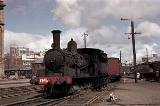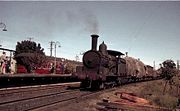
New South Wales Z19 class locomotive
Encyclopedia
The Z19 class is a class of steam locomotive
built for and operated by the New South Wales Government Railways
of Australia
.
, Wagga Wagga
and Orange
. The additional distances required an increase in motive power, especially as, at that time, locomotives were changed after quite short journeys. They were only in service when manned by their regular crew.
Between 1877 and 1881, the initial order of fifty of these 0-6-0
wheel arrangement locomotives were delivered from the designer, Beyer, Peacock and Company
. Between 1880 and 1891, a further 27 engines were delivered from Beyer, Peacock and local manufacturer, Henry Vale and Company.
 The load which these locomotives could haul over the Blue Mountains line was 128 tonnes at 11–13 km/h. William Thow, the then Locomotive Engineer of the South Australian Railways
The load which these locomotives could haul over the Blue Mountains line was 128 tonnes at 11–13 km/h. William Thow, the then Locomotive Engineer of the South Australian Railways
, was commissioned by the New South Wales Government in 1888 to enquire into the New South Wales Government Railways
locomotives and rolling stock. He recommended modifications to this class as he considered them to be the best designed and proportioned of the locomotives then in service.
Following the reclassification of locomotives in 1891, three additional similar locomotives were added to the class.
Having a short wheelbase and no leading truck, the locomotives had a tendency to derail and they were ultimately restricted to a maximum speed of 40 km/h and relegated to shunting and branch line traffic. Driven slowly, they could negotiate the most appalling curves and badly maintained or unballasted tracks. They were therefore ideal in goods yards, such as Darling Harbour where many survived right to the end of steam. Branch lines such as Dorrigo, Batlow and Oberon where grades of up to 1 in 25 and curves as sharp as 100m radius could be encountered were ideal for this class.

Steam locomotive
A steam locomotive is a railway locomotive that produces its power through a steam engine. These locomotives are fueled by burning some combustible material, usually coal, wood or oil, to produce steam in a boiler, which drives the steam engine...
built for and operated by the New South Wales Government Railways
New South Wales Government Railways
The New South Wales Government Railways was the government department that operated the New South Wales Government's railways until the establishment of the Public Transport Commission in 1972. Although later known officially as the Department of Railways, New South Wales, it was still generally...
of Australia
Australia
Australia , officially the Commonwealth of Australia, is a country in the Southern Hemisphere comprising the mainland of the Australian continent, the island of Tasmania, and numerous smaller islands in the Indian and Pacific Oceans. It is the world's sixth-largest country by total area...
.
History
By 1877, the main lines in New South Wales were nearing TamworthTamworth, New South Wales
Tamworth is a city in the New England region of New South Wales, Australia. Straddling the Peel River, Tamworth, which contains an estimated population of 47,595 people, is the major regional centre for southern New England and in the local government area of Tamworth Regional Council. The city...
, Wagga Wagga
Wagga Wagga, New South Wales
Wagga Wagga is a city in New South Wales, Australia. Straddling the Murrumbidgee River, and with an urban population of 46,735 people, Wagga Wagga is the state's largest inland city, as well as an important agricultural, military, and transport hub of Australia...
and Orange
Orange, New South Wales
Orange is a city in the Central West region of New South Wales, Australia. It is west of the state capital, Sydney, at an altitude of . Orange has an estimated population of 39,329 and the city is a major provincial centre....
. The additional distances required an increase in motive power, especially as, at that time, locomotives were changed after quite short journeys. They were only in service when manned by their regular crew.
Between 1877 and 1881, the initial order of fifty of these 0-6-0
0-6-0
Under the Whyte notation for the classification of steam locomotives, 0-6-0 represents the wheel arrangement of no leading wheels, six powered and coupled driving wheels on three axles, and no trailing wheels...
wheel arrangement locomotives were delivered from the designer, Beyer, Peacock and Company
Beyer, Peacock and Company
Beyer, Peacock and Company was an English railway Locomotive manufacturer with a factory in Gorton, Manchester. Founded by Charles Beyer and Richard Peacock, it traded from 1854 until 1966...
. Between 1880 and 1891, a further 27 engines were delivered from Beyer, Peacock and local manufacturer, Henry Vale and Company.

South Australian Railways
South Australian Railways built and operated railways in South Australia from 1854 to the incorporation of its non-urban railways into the Australian National Railways Commission in 1975, together with the former Commonwealth Railways and the former Tasmanian Government Railways...
, was commissioned by the New South Wales Government in 1888 to enquire into the New South Wales Government Railways
New South Wales Government Railways
The New South Wales Government Railways was the government department that operated the New South Wales Government's railways until the establishment of the Public Transport Commission in 1972. Although later known officially as the Department of Railways, New South Wales, it was still generally...
locomotives and rolling stock. He recommended modifications to this class as he considered them to be the best designed and proportioned of the locomotives then in service.
Following the reclassification of locomotives in 1891, three additional similar locomotives were added to the class.
Having a short wheelbase and no leading truck, the locomotives had a tendency to derail and they were ultimately restricted to a maximum speed of 40 km/h and relegated to shunting and branch line traffic. Driven slowly, they could negotiate the most appalling curves and badly maintained or unballasted tracks. They were therefore ideal in goods yards, such as Darling Harbour where many survived right to the end of steam. Branch lines such as Dorrigo, Batlow and Oberon where grades of up to 1 in 25 and curves as sharp as 100m radius could be encountered were ideal for this class.
Presevation
Four locomotives of the class have survived into presevation. These are:- 1905 on static display at New South Wales Rail Transport MuseumNew South Wales Rail Transport MuseumThe New South Wales Rail Transport Museum located in Thirlmere, New South Wales south-west of Sydney, is a museum dedicated to displaying former locomotives, carriages and goods wagons from the New South Wales Government Railways as well as private operations in NSW. The collection features steam,...
. - 1919 resides at the Glenreagh Mountain RailwayGlenreagh Mountain RailwayGlenreagh Mountain Railway, known as the GMR, was established in 1989 as a heritage tourist railway at Glenreagh, near Coffs Harbour, New South Wales, Australia...
in operational condition. - 1904 and 1923 are both at the Dorrigo Steam Railway and MuseumDorrigo Steam Railway and MuseumThe Dorrigo Steam Railway and Museum in Dorrigo, New South Wales, Australia is a large, privately owned collection of preserved railway vehicles and equipment from the railways of New South Wales, covering both Government and private railways...
.
See also

- Minimum railway curve radius

